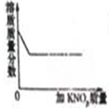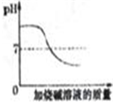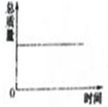问题
选择题
下列所示图象能正确反映对应的实验或事实的是( )
| A | B | C | D | |
| 图象 |
|
|
|
|
| 实验或事实 | 将等质量的镁和铝分别与足量的盐酸反应 | 20℃时,向一杯不饱和的KNO3溶液中逐步加入KNO3晶体 | 向稀盐酸中滴加过量的烧碱溶液 | 将一定质量的碳在密闭容器中(含空气)加热 |
A.A
B.B
C.C
D.D
答案
A、等质量的镁和铝与足量盐酸反应时,铝产生的氢气多,镁比铝活泼反应快,即铝产生氢气的特点是“多而慢”,在坐标上表现为铝产生氢气的曲线在上方,曲线的斜率比镁小;故A不能正确反映其对应实验操作;
B、20℃时,向一杯不饱和的KNO3溶液中逐步加入KNO3晶体,溶液的溶质质量分数应该变大,达到饱和时就不会发生变化了,故B不能正确反映其对应实验操作;
C、向稀盐酸中滴加过量的烧碱溶液,溶液的起点是pH<7,随着反应的进行,酸性逐渐减弱,pH变大,到氢氧化钠过量时,溶液的pH>7,故C不能正确反映其对应实验操作;
D、根据质量守恒定律,化学反应前后物质的总质量不发生改变,故D能正确反映其对应实验操作.
故选D.




